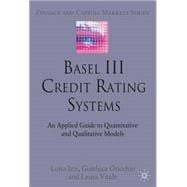
| List of Figures | p. viii |
| List of Tables | p. xii |
| List of Abbreviations | p. xv |
| Acknowledgements | p. xviii |
| Foreword | p. xix |
| Introduction: The Efficient Market Hypothesis and Basel III New Banking Regulations | p. 1 |
| The Quantitative Approach to Credit Rating Models | |
| Corporate SME and Retail PD models | p. 11 |
| PD corporate SME model development | p. 11 |
| PD corporate SME sub-segment models | p. 43 |
| PD retail models development | p. 60 |
| Sovereign and Banks' Rating Models | p. 68 |
| Country rating model | p. 71 |
| Bank rating model | p. 77 |
| Exposure at Default Valuation | p. 89 |
| Calculating EAD components | p. 92 |
| Granularity of CCF | p. 95 |
| Application of average values to the current portfolio | p. 96 |
| From historical medium value to an ex ante EAD model | p. 97 |
| Loss Given Default Estimation | p. 102 |
| Structure of the LGD workout calculation | p. 102 |
| Downturn LGD | p. 110 |
| From workout to an ex ante LGD model | p. 111 |
| Validation of Internal Credit Models | p. 114 |
| Validation of the PD model | p. 116 |
| LGD model validation | p. 121 |
| EAD model's validation | p. 125 |
| PD validation statistical test | p. 133 |
| The Qualitative Approach to Credit Rating Models | |
| The Internal Rating Agency: Organization and Scope | p. 147 |
| Expert Judgment-based Rating Assignment Process | p. 155 |
| Introduction | p. 155 |
| Obligor 'corporate' definition | p. 156 |
| Rating horizon | p. 157 |
| High-level step-by-step guide to final rating | p. 158 |
| Key drivers of the stand-alone rating | p. 161 |
| Definition of support | p. 171 |
| Identification of the support entity | p. 172 |
| Nature of support | p. 173 |
| Final rating | p. 177 |
| Rating assignment on investment holding companies | p. 178 |
| Implication of convertibility risk | p. 180 |
| Slotting Criteria Credit Rating Models | p. 182 |
| From risk factors to maturity profiles | p. 182 |
| Maturity profiles and the slotting process | p. 186 |
| Putting it all together: the importance of slotting | p. 188 |
| Global Recovery Rate | p. 194 |
| Introduction | p. 194 |
| Unsecured global recovery rate: definition and drivers | p. 196 |
| Secured global recovery rate | p. 198 |
| Particular cases of global recovery rate | p. 203 |
| Exposure at default valuation | p. 204 |
| Rating Assignment on Specialized Lending | |
| Rating Assignment on Project Finance | p. 209 |
| Project phase rating | p. 209 |
| Project's stand-alone rating | p. 211 |
| Support and final rating | p. 211 |
| Senior unsecured GRR | p. 211 |
| GRR secured at the facility level | p. 212 |
| Rating Assignment on Object Finance | p. 215 |
| Rating assignment on LBOs | p. 215 |
| Rating assignment on shipping finance | p. 220 |
| Rating assignment on airlines and operating lessors | p. 225 |
| Rating Assignment on Telecom Operators | p. 232 |
| Stand-alone rating | p. 233 |
| Risk-Adjusted Credit Pricing Models | |
| Pricing in Liquid Markets | p. 243 |
| Introduction | p. 243 |
| The Merton structural default model©1 | p. 243 |
| The mathematical model | p. 250 |
| Nelson-Siegel: a parametric approach | p. 251 |
| The credit default swap5 | p. 251 |
| Liquid curves | p. 254 |
| Non-liquid curves | p. 255 |
| CDS-implied EDF Credit Measures and Fair-value Spreads1 | p. 257 |
| Introduction | p. 257 |
| Overview | p. 258 |
| Practical applications of CDS-implied EDF measures and fair-value spreads | p. 260 |
| CDS-implied EDF model and fair-value spread model | p. 272 |
| Applying the framework to sovereigns | p. 284 |
| Summary | p. 293 |
| Frequently asked questions | p. 294 |
| Pricing in Nonliquid Markets | p. 302 |
| Introduction | p. 302 |
| Transition matrix state: dependent pricing model | p. 311 |
| Analytics of pricing models | p. 323 |
| Pricing of a pre-payment option | p. 330 |
| Notes | p. 334 |
| References | p. 339 |
| Index | p. 343 |
| Table of Contents provided by Ingram. All Rights Reserved. |
The New copy of this book will include any supplemental materials advertised. Please check the title of the book to determine if it should include any access cards, study guides, lab manuals, CDs, etc.
The Used, Rental and eBook copies of this book are not guaranteed to include any supplemental materials. Typically, only the book itself is included. This is true even if the title states it includes any access cards, study guides, lab manuals, CDs, etc.